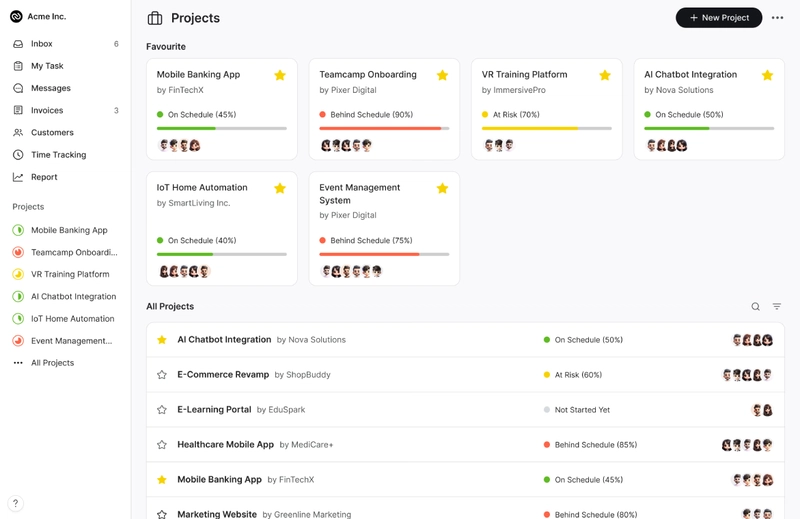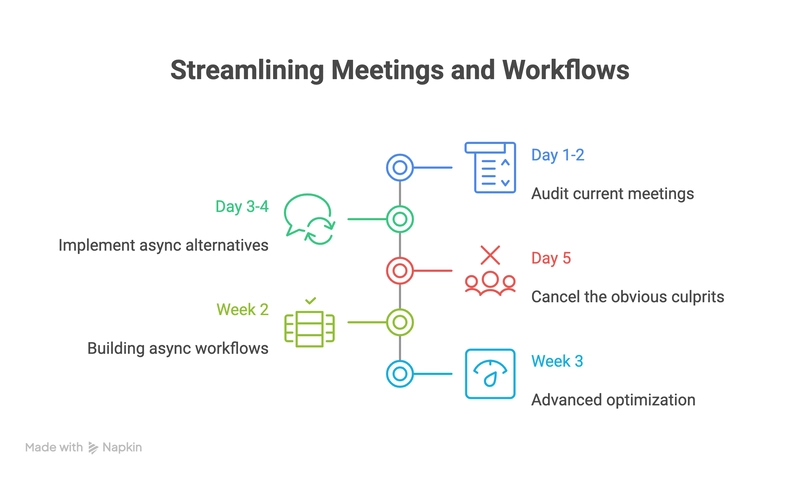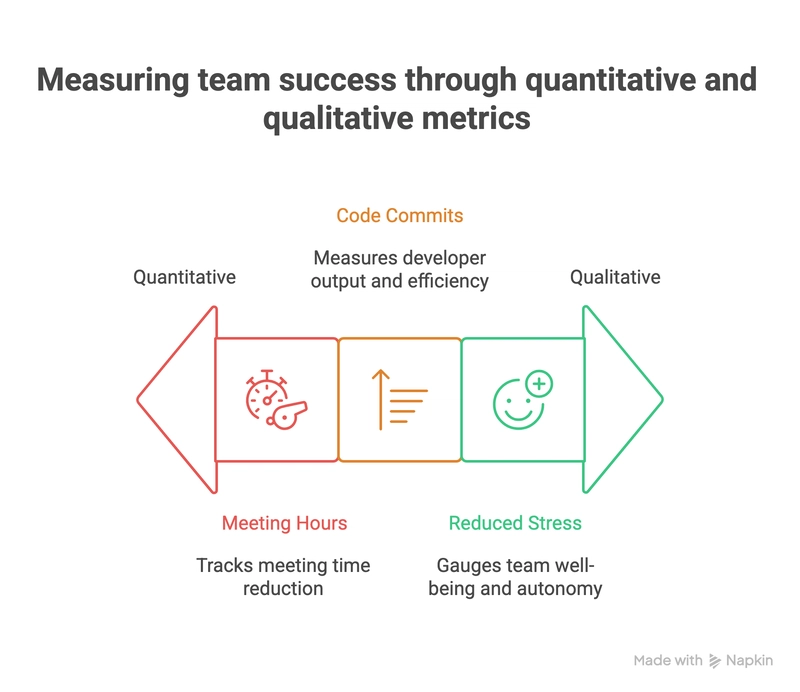The Zoom Fatigue Fix: How Top Remote Devs Run 90% Fewer Meetings
The average developer spends 23 hours per week in meetings. Let that sink in; that’s nearly 60% of a standard work week consumed by discussions instead of actual coding. If you’re reading this with a calendar full of back-to-back Zoom calls, you’re not alone. The remote work revolution promised freedom, but for many developers, it delivered meeting hell instead.
But here’s the kicker: the most productive remote developers I know run 90% fewer meetings than their peers. They are not antisocial; they are strategic.
They have cracked the code on async collaboration, smart communication patterns, and meeting-optional workflows that would make any productivity guru jealous.
The Hidden Cost of Meeting Overload for Developers
Why Meetings Are Particularly Toxic for Developer Productivity
Unlike other roles, coding requires deep focus states that can take 15-30 minutes to achieve. When you’re juggling sprint planning, daily standups, code reviews, stakeholder demos, and “quick sync” calls, you’re essentially fragmenting your brain into unusable chunks.
Explore Teamcamp to integrated workflow management
The Developer’s Dilemma:
- Context switching between meetings destroys flow state
- Async-friendly tasks get forced into real-time discussions
- Problem-solving becomes performative rather than thoughtful
- Documentation suffers when everything happens in verbal exchanges
Research from the Harvard Business Review shows that developers interrupted by meetings experience a 40% drop in code quality and a 25% increase in bug rates.
💡
The math is brutal: more meetings = worse code.
The 90% Reduction Strategy: How Elite Remote Devs Operate
1. The Async-First Mindset Shift
Top remote developers operate on a simple principle: if it can be documented, it shouldn’t be a meeting. This isn’t about being antisocial—it’s about respecting the cognitive demands of complex problem-solving.
The Async Hierarchy:
- Level 1: Written documentation and specs
- Level 2: Asynchronous video explanations
- Level 3: Scheduled pair programming sessions
- Level 4: Real-time meetings (only for complex decisions)
2. Smart Communication Patterns
Elite remote developers have mastered the art of overcommunication without over-meeting. They use structured communication that eliminates the need for constant check-ins.
Daily Async Standup Template:
Yesterday: [Completed tasks with links to PRs/commits]
Today: [Planned work with time estimates]
Blockers: [Specific issues needing input - tag relevant people]
Context: [Brief explanation of any complex decisions made]
3. Meeting Alternatives That Actually Work
-
Code Review Sessions → Async PR Reviews
Instead of scheduling review meetings, top developers use structured PR templates with clear acceptance criteria. Comments replace conversations, and decisions get documented automatically.
-
Planning Sessions → Collaborative Documentation
Rather than marathon planning meetings, successful remote teams use shared documents where requirements evolve asynchronously. Everyone contributes when they’re in their optimal thinking state.
-
Status Updates → Automated Dashboards
The best remote developers never attend status meetings. They build dashboards that show progress in real-time, making update meetings obsolete.
The Technology Stack for Meeting-Light Development
1. Essential Tools for Async Collaboration
Documentation-First Platforms:
- Notion or Confluence for requirements and decisions
- Loom for complex explanations that need visual context
- GitHub Issues for structured problem-solving
- Slack threads for focused discussions
Project Management That Eliminates Status Meetings:
This is where platforms like Teamcamp become game-changers. Unlike traditional project management tools that require constant meetings to stay aligned, Teamcamp provides real-time visibility into project progress, task dependencies, and team capacity. Developers can see exactly what’s happening across projects without joining a single status call.
With Teamcamp’s integrated workflow management, remote development teams can:
- Track sprint progress without daily standups
- Manage code review cycles asynchronously
- Coordinate releases without coordination meetings
- Handle stakeholder updates through automated reporting
Explore Teamcamp to integrated workflow management
The “Meeting Audit” Framework
Before any meeting gets scheduled, top remote developers ask these questions:
The 5-Question Meeting Filter:
- Can this be a document instead?
- Does this require real-time input from everyone invited?
- Will this produce a decision that needs immediate action?
- Is the cost of async communication higher than the meeting cost?
- Have we clearly defined what success looks like?
If you can’t answer “yes” to at least three of these, it’s not a meeting ; it is a notification.
Real-World Case Studies: Teams That Cracked the Code
Case Study 1: The 15-Person Engineering Team with 2 Weekly Meetings
- Company: Mid-stage fintech startup
- Challenge: Coordination across frontend, backend, and mobile teams
- Solution: Async-first architecture with smart tooling
Their System:
- Monday: Async planning in shared documents
- Wednesday: Optional office hours for complex problems
- Friday: Async demo recordings shared with stakeholders
- Result: 90% meeting reduction, 35% faster delivery cycles
Case Study 2: The Open Source Maintainer Managing 50+ Contributors
- Challenge: Coordinating global contributors across time zones
- Solution: Documentation-driven development with clear contribution paths
Their Approach:
- Detailed contribution guidelines eliminate onboarding meetings
- Async code review processes with clear feedback loops
- Monthly contributor newsletters replace status calls
- GitHub Discussions for complex architectural decisions
The Practical Implementation Guide
Week 1: The Meeting Detox
Day 1-2: Audit current meetings
- List all recurring meetings
- Calculate time spent per week
- Identify which meetings could be documents
Day 3-4: Implement async alternatives
- Create standup templates
- Set up automated progress tracking
- Establish clear communication protocols
Day 5: Cancel the obvious culprits
- Eliminate status meetings with dashboard alternatives
- Convert planning sessions to collaborative docs
- Replace quick syncs with structured Slack threads
Week 2: Building Async Workflows
Documentation Systems:
- Create decision logs for important choices
- Build requirement templates that eliminate clarification meetings
- Establish code review standards that prevent review meetings
Communication Protocols:
- Define when to use different communication channels
- Create escalation paths for blocked work
- Set expectations for response times
Week 3: Advanced Optimization
Tool Integration:
- Connect project management tools to code repositories
- Set up automated progress reporting
- Create stakeholder dashboards that eliminate update meetings
Team Alignment:
- Train team members on async communication best practices
- Establish meeting-free time blocks for deep work
- Create accountability systems that don’t require check-ins
The Psychological Benefits of Meeting-Light Development
1. Reclaiming Deep Work
When developers reduce meetings by 90%, they don’t just save time—they reclaim their cognitive architecture. Deep work becomes possible again. Complex problems get the sustained attention they deserve.
The Compounding Effects:
- Better code quality from uninterrupted focus
- Faster problem-solving without context switching
- Reduced stress from constant calendar pressure
- Improved work-life balance through predictable schedules
2. Building Asynchronous Empathy
Counter-intuitively, teams that meet less often communicate more thoughtfully. When you can’t rely on face-to-face clarification, you become more precise in your written communication. This leads to better documentation, clearer requirements, and more inclusive team dynamics.
Common Pitfalls and How to Avoid Them
1. The Overcorrection Trap
Some teams swing too far toward async and lose the human connection. The goal isn’t to eliminate all real-time interaction—it’s to make meetings intentional and valuable.
The Balance:
- Keep brainstorming sessions for complex architectural decisions
- Maintain pair programming for knowledge sharing
- Schedule regular one-on-ones for team relationship building
- Use video calls for conflict resolution and sensitive discussions
2. The Documentation Burden
Async-first doesn’t mean document-everything. Create lightweight documentation that serves the team, not comprehensive manuals that nobody reads.
Smart Documentation Principles:
- Focus on decisions, not processes
- Use templates to reduce writing overhead
- Keep docs living and updateable
- Link documentation to code for context
Tools and Platforms That Enable Meeting-Light Development
1. Integrated Project Management Solutions
Teamcamp stands out as an all-in-one platform designed specifically for remote development teams. Unlike fragmented tool chains that require constant meetings to maintain alignment, Teamcamp provides:
- Real-time project visibility that eliminates status meetings
- Integrated task management that connects code to business objectives
- Automated progress tracking that keeps stakeholders informed without developer involvement
- Smart notification systems that reduce communication overhead
The platform’s strength lies in its ability to create transparency without meetings. Developers can focus on coding while stakeholders get the visibility they need through automated reporting and real-time dashboards.
2. Communication Architecture
The Three-Tier Communication Model:
- Immediate (< 1 hour): Slack for urgent blockers
- Daily (< 24 hours): Project management updates and PR reviews
- Weekly (< 7 days): Strategic discussions and planning documents
Measuring Success: KPIs for Meeting-Light Teams
1. Quantitative Metrics
Meeting Reduction Indicators:
- Meeting hours per developer per week
- Percentage of work time spent in meetings
- Number of recurring meetings eliminated
- Time between decision and implementation
Productivity Improvements:
- Code commits per developer per week
- Time from feature request to deployment
- Bug rates and code quality metrics
- Developer satisfaction scores
2. Qualitative Improvements
Team Health Indicators:
- Reduced stress about calendar management
- Improved work-life balance
- Better documentation quality
- Increased autonomy and ownership
The Future of Remote Development Collaboration
1. Emerging Trends
The most successful remote development teams are moving toward:
- AI-powered project management that predicts blockers before they happen
- Automated status reporting that eliminates update meetings entirely
- Context-aware communication that routes information to the right people at the right time
- Predictive collaboration that suggests optimal working patterns
2. The Competitive Advantage
Companies that master meeting-light development will have a significant advantage in attracting top talent. Developers are increasingly choosing employers based on respect for deep work and sustainable collaboration practices.
Conclusion: Your Path to Meeting-Light Development
The evidence is clear: the most productive remote developers have cracked the code on async collaboration. They’ve eliminated 90% of their meetings not through antisocial behavior, but through smart systems, clear communication, and strategic tool choices.
The transition isn’t just about saving time, it’s about reclaiming the cognitive space that makes great software possible. When developers can focus on complex problems without constant interruption, the quality of their work improves dramatically.
Ready to transform your remote development workflow? Start with a meeting audit this week. Identify the low-hanging fruit those status meetings that could be dashboards, those planning sessions that could be documents, those quick syncs that could be Slack threads.
For teams serious about sustainable remote collaboration, Teamcamp offers the integrated project management foundation that makes meeting-light development possible. With its focus on transparency, automation, and developer-friendly workflows, it’s designed to help remote teams coordinate effectively without coordination overhead.
The future of remote development isn’t about better video calls , it’s about needing fewer of them. The developers who master this shift will build better software, have better work-life balance, and create more sustainable careers in our increasingly remote world.
Your calendar is waiting. Your code is waiting. Your sanity is definitely waiting.
What meeting will you eliminate first?
Calculate Your Remote Team Productivity with our Team Productivity calculator









